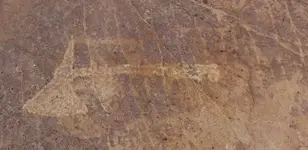You are using an out of date browser. It may not display this or other websites correctly.
You should upgrade or use an alternative browser.
You should upgrade or use an alternative browser.
ANCIENT VOICES: Ditlihi's Journey Into The Truth Of Ancient Treasure In The Southwest
- Thread starter Ditlihi
- Start date
- Status
- Not open for further replies.
listopiedras
Full Member
- Joined
- Nov 21, 2020
- Messages
- 132
- Reaction score
- 176
- Golden Thread
- 0
- Primary Interest:
- All Treasure Hunting
Representation of a medieval halberd-type weapon ... ? Doesn't seem like a common tomahawk with that opposing point. Cookes Range, Sappo Canyon area.
View attachment 1907950

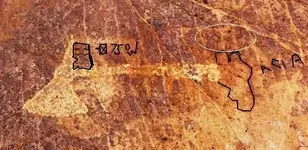
It absolutely looks like a medieval halberd or a medieval battle axe rather than a tomahawk. You can even distinguish the metallurgical work between the cutting edge and the wooden handle being very well defined. That is no stone-head wrapped tomahawk with leather bindings or twigs as per indigenous crafts. Also, the skill of the “artist’ that drew that pictogram with the details presented, is far above native skills .
However, it’s a little more then it first meets the eye at first.
Right under the business end of the battle axe, lower on the handle, it has a Fanion (https://en.wikipedia.org/wiki/Fanion) which is customary to identify the group.
Between the ‘fanion’ and the sharp tip of the axe –which is a directional arrow point- is a rectangular Packman-like figurine that resembles an owl.
At owl’s eye level it is given a direction of 75 degrees due West, ……..To…..
…..the end of the Axe’s handle which has a map-like shape or a landmark of sorts.
It would be a real confirmation if,.......IF the AXe’s handle is actually pointing West.
At the very end, it is an incomplete and faded inscription in Latin that spells either: “acia” = thread, yarn.....or if indeed is incomplete then could be the root of the word “acistarium” = monastery, or the root of the word “aciscularius, aciscularii” which is a “stone-cutter” or “worker with an adze”. However, the word “acisulus, acisuli” means a little Adze.
Nevertheless, this pictogram is intriguing enough to warrant more exploration, if the Axe’s handle really points toward West.
P.S. Try to enlarge the pictures to double the size (or more), to see the details noted.
Edit:..... It is possible that are two directions to investigate:....
...the sharp tip point of the axe that looks like an arrow and has the "owl" depicted, should point West.
....the end of the handle may poit to a structure or landmark, possibly used as a base camp or some other long stay position.
It should be interesting to follow both.
Last edited:
sdcfia
Silver Member
Interesting info, listo - thanks. Here's more. The photo I posted was cropped to show only the weapon. There's more nearby, see below. The "signature", "MARION . MC CY.B", was presumably added later, as the work was seemingly done with much better tools. We speculate the signature was of the person who built and occupied ruins of an old shelter nearly, and used other structures in the area - rock corral, rock spring box. Never able to find any record of a man with a name that fit the carving or various spellings of it.
Above the weapon's pointer side is an old faded pecking of a snake, presumably created before the weapon was. Above the snake are two bedrock mortars. I have my doubts about the accepted explanation for the use of bedrock mortars - at least in some cases. These photos were taken quite a few years ago and are unfortunately low resolution. You're right - this area deserves some more time.
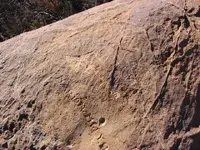
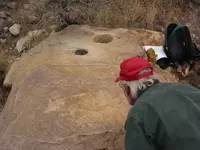

Above the weapon's pointer side is an old faded pecking of a snake, presumably created before the weapon was. Above the snake are two bedrock mortars. I have my doubts about the accepted explanation for the use of bedrock mortars - at least in some cases. These photos were taken quite a few years ago and are unfortunately low resolution. You're right - this area deserves some more time.



Last edited:
listopiedras
Full Member
- Joined
- Nov 21, 2020
- Messages
- 132
- Reaction score
- 176
- Golden Thread
- 0
- Primary Interest:
- All Treasure Hunting
Interesting info, listo - thanks. Here's more. The photo I posted was cropped to show only the weapon. There's more nearby, see below. The "signature", "MARION . MC Y.B", was presumably added later, as the work was seemingly done with much better tools. We speculate the signature was of the person who built and occupied ruins of an old shelter nearly, and used other structures in the area - rock corral, rock spring box. Never able to find any record of a man with a name that fit the carving or various spellings of it.
Above the weapon's pointer side is an old faded pecking of a snake, presumably created before the weapon was. Above the snake are two bedrock mortars. I have my doubts about the accepted explanation for the use of bedrock mortars - at least in some cases. These photos were taken quite a few years ago and are unfortunately low resolution. You're right - this area deserves some more time.
View attachment 1908341
View attachment 1908342
View attachment 1908343
Ha, why am I not surprised, lol…
It seems that you have already found the base camp, Sdc. Great.
I’m going to need a little more time to spend on the whole new material you posted, since there’s a lot of information coming forth from those pictures.
At first look, it seems that some ‘special group’ has spent a lot of time in your area. Let’s see why?
First off, I need some simple questions answered without getting too specific on information that you may understandably hold back.
…..inside the structure that you call ‘cabin’ or shelter there’s a higher wall still standing. Does that wall have some sort of crude fireplace at the base? Also, …on the exterior side of the wall, is there a taller than usual flat stone that could have been used as an improvised altar?
……on the bedrock mortars, …do you remember how deep they are? (I do agree with you about them not being used for grain)
We’ll get to the ‘signature inscription’ and its time table and tools used, later.
The Snake however, deserves a lot more attention. Do you happen to have a picture of it in its entirety? If you do, do you think you can post it?
You do indeed have a few riddles that have to be solved, but you also have some helpful symbols ‘ad facia’ that are straight forward and true to the meaning. The most confusing is of course the coordinates given. I hope that your snake can clarify and straighten that meaning.
I’ll get back on it after spending a little time with your answers.
sdcfia
Silver Member
## From listopiedras:
## First off, I need some simple questions answered without getting too specific on information that you may understandably hold back.
I'm glad to answer what I can remember, however it's been 12-14 years since I was at this site. We documented quite a bit there with photos, but we had a primary destination nearby that day. This halberd site slipped into the "curiosity file" and never got any more attention.
## …..inside the structure that you call ‘cabin’ or shelter there’s a higher wall still standing. Does that wall have some sort of crude fireplace at the base? Also, …on the exterior side of the wall, is there a taller than usual flat stone that could have been used as an improvised altar?
As I recall, there was a crude fireplace in that corner. Here's another photo of it.

## ……on the bedrock mortars, …do you remember how deep they are? (I do agree with you about them not being used for grain)
Didn't measure them, but inspected them and thought they were too deep to be easily worked and were located in a position that would have not been comfortable. Common metates and manos are obviously easier to make and use for grinding grains, IMO.
We’ll get to the ‘signature inscription’ and its time table and tools used, later.
## The Snake however, deserves a lot more attention. Do you happen to have a picture of it in its entirety? If you do, do you think you can post it?
I would, but I have no more photos of the snake.
## You do indeed have a few riddles that have to be solved, but you also have some helpful symbols ‘ad facia’ that are straight forward and true to the meaning. The most confusing is of course the coordinates given. I hope that your snake can clarify and straighten that meaning.
I’ll get back on it after spending a little time with your answers.
While intriguing, I have to say this site was not the most important riddle we spent time on in the Cookes Range - not by a long shot. However, the weapon petroglyph intrigued us. Also the rock corral and the odd "shrine" against the big boulder at its end (below). Your comments are rekindling my interest. Thanks for whatever ideas you have - might have to go back for a new looksee.
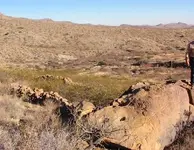

## First off, I need some simple questions answered without getting too specific on information that you may understandably hold back.
I'm glad to answer what I can remember, however it's been 12-14 years since I was at this site. We documented quite a bit there with photos, but we had a primary destination nearby that day. This halberd site slipped into the "curiosity file" and never got any more attention.
## …..inside the structure that you call ‘cabin’ or shelter there’s a higher wall still standing. Does that wall have some sort of crude fireplace at the base? Also, …on the exterior side of the wall, is there a taller than usual flat stone that could have been used as an improvised altar?
As I recall, there was a crude fireplace in that corner. Here's another photo of it.

## ……on the bedrock mortars, …do you remember how deep they are? (I do agree with you about them not being used for grain)
Didn't measure them, but inspected them and thought they were too deep to be easily worked and were located in a position that would have not been comfortable. Common metates and manos are obviously easier to make and use for grinding grains, IMO.
We’ll get to the ‘signature inscription’ and its time table and tools used, later.
## The Snake however, deserves a lot more attention. Do you happen to have a picture of it in its entirety? If you do, do you think you can post it?
I would, but I have no more photos of the snake.
## You do indeed have a few riddles that have to be solved, but you also have some helpful symbols ‘ad facia’ that are straight forward and true to the meaning. The most confusing is of course the coordinates given. I hope that your snake can clarify and straighten that meaning.
I’ll get back on it after spending a little time with your answers.
While intriguing, I have to say this site was not the most important riddle we spent time on in the Cookes Range - not by a long shot. However, the weapon petroglyph intrigued us. Also the rock corral and the odd "shrine" against the big boulder at its end (below). Your comments are rekindling my interest. Thanks for whatever ideas you have - might have to go back for a new looksee.


Last edited:
listopiedras
Full Member
- Joined
- Nov 21, 2020
- Messages
- 132
- Reaction score
- 176
- Golden Thread
- 0
- Primary Interest:
- All Treasure Hunting
## From listopiedras:
## First off, I need some simple questions answered without getting too specific on information that you may understandably hold back.
I'm glad to answer what I can remember, however it's been 12-14 years since I was at this site. We documented quite a bit there with photos, but we had a primary destination nearby that day. This halberd site slipped into the "curiosity file" and never got any more attention.
## …..inside the structure that you call ‘cabin’ or shelter there’s a higher wall still standing. Does that wall have some sort of crude fireplace at the base? Also, …on the exterior side of the wall, is there a taller than usual flat stone that could have been used as an improvised altar?
As I recall, there was a crude fireplace in that corner. Here's another photo of it.
View attachment 1908490
## ……on the bedrock mortars, …do you remember how deep they are? (I do agree with you about them not being used for grain)
Didn't measure them, but inspected them and thought they were too deep to be easily worked and were located in a position that would have not been comfortable. Common metates and manos are obviously easier to make and use for grinding grains, IMO.
We’ll get to the ‘signature inscription’ and its time table and tools used, later.
## The Snake however, deserves a lot more attention. Do you happen to have a picture of it in its entirety? If you do, do you think you can post it?
I would, but I have no more photos of the snake.
## You do indeed have a few riddles that have to be solved, but you also have some helpful symbols ‘ad facia’ that are straight forward and true to the meaning. The most confusing is of course the coordinates given. I hope that your snake can clarify and straighten that meaning.
I’ll get back on it after spending a little time with your answers.
While intriguing, I have to say this site was not the most important riddle we spent time on in the Cookes Range - not by a long shot. However, the weapon petroglyph intrigued us. Also the rock corral and the odd "shrine" against the big boulder at its end (below). Your comments are rekindling my interest. Thanks for whatever ideas you have - might have to go back for a new looksee.
View attachment 1908498
View attachment 1908499
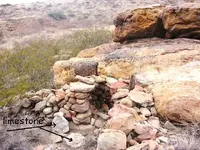
Sdcfia quoted:
“Also the rock corral and the odd "shrine" against the big boulder at its end………” end quote.
The semicircle/half-round constructed structure was carefully located behind that big boulder (for safety reasons) and was also reinforced from all sides. It is not an old odd shaped shrine, but rather an enclosure to keep the fire going for days.
It is a combination between a forge (for metal woks such as tool repairs and reshaping and occasional weapons as needed) and also a kiln or furnace for reducing limestone to lime by burning. The process is called Calcination, and by burning limestone (which is calcium carbonate) gives you quick lime, or calcium oxide. Then, the ‘cooked’ solid rock was then broken in smaller fragments to fit inside the bedrock mortars where it was crushed into a fine powder Lime. Mixed with water this produced slaked lime (calcium hydroxide) used together with additives like crushed slag, ashes, sometimes black sand and/or any other type of iron oxides from the furnace. The final slaked putty would be mixed with fine sand for consistency to form a very strong stucco-like mortar which is weather resistant, hard but flexible and self healing when it rains.
The half enclosed space would keep the fire contained, but would also transfer heat to that big boulder, which came very handy to the people camped there in the cold desert nights.
So, there goes your working camp routine….
The work area that includes the bedrock mortars for crushing limestone is close to the forge/kiln on the other side of the boulder, but while inside the corral it was easy to unload the horses and mules and let them roam inside, while the men got busy.
Next question would naturally be…..’why go through all that trouble to make that strong binding material?’
The answer will be obvious in the next picture and segment. And the next after that.
listopiedras
Full Member
- Joined
- Nov 21, 2020
- Messages
- 132
- Reaction score
- 176
- Golden Thread
- 0
- Primary Interest:
- All Treasure Hunting

While looking at the pictogram of the weapon and the inscription under it, you must have seen the elliptical line/enclosure encompassing the snake, the weapon and the inscription itself. Why circled and enclosed?
Above the enclosure, the two bedrock mortars are situated on a much more eroded surface,…..and also stained on one side but clear and eroded on the opposite side.
That white powder-like stain is no organic matter from crushing grains.
It is ancient lime dust that got imbedded into the stone by a caustic chemical reaction. It did not wash away with acid rain and never will. But you can see the flaking stone surface a little farther behind, while the flowing or dripping surface in between is smooth and clean from repeated washing during the course of emptying that mortar by hand. It was a very labor intense work and repeated for a long time.
The circled area that has the message and pictogram was protected by two factors: …one…it was slightly elevated by applying a thin coat of mortar with a trowel and smoothed out. Second ….a coat of diluted acid mixed with iron oxide (possible black sand dissolved) was applied for protection. Upon the chemical reaction, a P/H equilibrium was reached and the surface was penetrated and hardened just enough for the last step,………………the beautiful carvings and inscription which was done while the surface was still wet and workable.
That is the mystery of your perfect carvings with no tool marks. Skill…? Yes.
It was all done at the same time by the same master mason/artist.

The inscription has 2 C's instead of one,...it reads " MARION .M C C Y. B"
Last edited:
sdcfia
Silver Member
Interesting observations, listo. I'm not sure I buy the limestone mortar idea. If you substitute caliche (abundant in the vicinity) for limestone, then, yes, the bedrock grinding holes could be an explanation for their existance - although their placement (two on the big rock at the head of the corral and two on the petroglyph boulder) are still curious to me, considering the other more user-friendly options.
The rock structure, like others common in the region, is at least partially stabilized with caliche mortar, which was relatively much easier to produce than full-blown roasted limestone cement. The crushing of the Lake Valley limestone in the range would have been quite a task with hand pestals. Also, I think lime kilns needed to be used (enclosed ovens) to generate enough heat. Still low tech, yes, but requiring more complex construction than an open fireplace. Be that as it may - it'd take more careful observation for me to make an opinion.
By the way, thanks for correcting my typo in Post #903. Marion McCyb was indeed how we read the carving and the name we searched for. Two Cs, now fixed.
The reason we kept this site on our list of things to do was the carving on the big rock above the structure at the head of the corral. "lilo". This word is found carved in the same distinct style at numerous "important" locations in the range and is controversial to some extent. Some folks assume it's merely the signature of a deer hunter from Deming who was active in the area back in the 1970s. To some extent, this may be true based on the apparent age and lettering style of some of the lilo carvings we've found. It's my thought that the deer hunter, for whatever reason, adopted the word for himself. A copycat.
My surveying buddy claims the word lilo is an old Hispanic term that means "in a line", and is positioned in specific locations as a point from which a line of sight observation is made. Based on evidence we've collected elsewhere in the range, I tend to agree with this idea.
The encircled carvings, their individual purposes and the collective set - I don't have much of a theory. There are other things not far from these that are more interesting, but again, there's so much to choose from in the range - especially at the Pony Hill, Frying Pan Canyon (Mine 7), Mines 5 and 6, et al sites. It's still the halberd that intrigues me at this point.
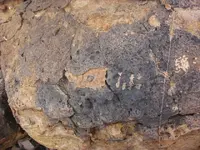
Old lilo at corral

New lilo
The rock structure, like others common in the region, is at least partially stabilized with caliche mortar, which was relatively much easier to produce than full-blown roasted limestone cement. The crushing of the Lake Valley limestone in the range would have been quite a task with hand pestals. Also, I think lime kilns needed to be used (enclosed ovens) to generate enough heat. Still low tech, yes, but requiring more complex construction than an open fireplace. Be that as it may - it'd take more careful observation for me to make an opinion.
By the way, thanks for correcting my typo in Post #903. Marion McCyb was indeed how we read the carving and the name we searched for. Two Cs, now fixed.
The reason we kept this site on our list of things to do was the carving on the big rock above the structure at the head of the corral. "lilo". This word is found carved in the same distinct style at numerous "important" locations in the range and is controversial to some extent. Some folks assume it's merely the signature of a deer hunter from Deming who was active in the area back in the 1970s. To some extent, this may be true based on the apparent age and lettering style of some of the lilo carvings we've found. It's my thought that the deer hunter, for whatever reason, adopted the word for himself. A copycat.
My surveying buddy claims the word lilo is an old Hispanic term that means "in a line", and is positioned in specific locations as a point from which a line of sight observation is made. Based on evidence we've collected elsewhere in the range, I tend to agree with this idea.
The encircled carvings, their individual purposes and the collective set - I don't have much of a theory. There are other things not far from these that are more interesting, but again, there's so much to choose from in the range - especially at the Pony Hill, Frying Pan Canyon (Mine 7), Mines 5 and 6, et al sites. It's still the halberd that intrigues me at this point.

Old lilo at corral

New lilo
listopiedras
Full Member
- Joined
- Nov 21, 2020
- Messages
- 132
- Reaction score
- 176
- Golden Thread
- 0
- Primary Interest:
- All Treasure Hunting
listopiedras
Full Member
- Joined
- Nov 21, 2020
- Messages
- 132
- Reaction score
- 176
- Golden Thread
- 0
- Primary Interest:
- All Treasure Hunting
sdcfia
Silver Member
And lost dogs too, ha ha.

Well, the story gets complicated, listo. It's a big picture thing, and surveyed patterns seem to be a common thread connecting at least some of the parts. Is there anything you see that may indicate a specific azimuth angle in the items you've pointed out on "tomahawk rock"? For us, this site occupies a position on a specific azimuth that links to another interesting feature in the Cookes Range - one with another adjacent "old lilo". Who, what, when, why - we don't know the answers, but numbers don't lie and I don't believe in repeating coincidences. BTW, the azimuth is 337° (or -23° if you prefer).
listopiedras
Full Member
- Joined
- Nov 21, 2020
- Messages
- 132
- Reaction score
- 176
- Golden Thread
- 0
- Primary Interest:
- All Treasure Hunting
And lost dogs too, ha ha.
View attachment 1908738
Well, the story gets complicated, listo. It's a big picture thing, and surveyed patterns seem to be a common thread connecting at least some of the parts. Is there anything you see that may indicate a specific azimuth angle in the items you've pointed out on "tomahawk rock"? For us, this site occupies a position on a specific azimuth that links to another interesting feature in the Cookes Range - one with another adjacent "old lilo". Who, what, when, why - we don't know the answers, but numbers don't lie and I don't believe in repeating coincidences. BTW, the azimuth is 337° (or -23° if you prefer).
That Lilo puppy has a guilty demeanor. He’s probably an escape artist. LOL
Well, the snake is traditionally a direction giver for many centuries. When it is pictured with body coils left and right, it usually represents the turns that your path
should follow to destination.
Your snake however, it’s a straight shooter and possibly pointing in the direction you’re looking for.
From the angle the (poor) picture was taken, looks almost parallel to the upper tip of the cutting edge of the axe. It looks almost like a natural way a person would point at ‘something’ in distance while holding that weapon in his hand.
I’m not sure if this will answer the general question, but I can tell that your snake has a thick body for a reason and I can see additional designs and markings within. Those messages carved inside, are very important to complete understanding of their intent. So far, and from that distance and angle, the only visible markings are some wavy line that could represent some sort of landmarks (hills, etc) to a specific point or destination. Much more information should be visible with several close-ups taken with a decent resolution. Another important element is the snake’s tail and possible curvature or the shape of the tail end, which in your case is completely obstructed.
So then, if you happen to go out sometimes looking for your lost puppy Lilo (lol), drop by the Lilo-corral and take some fresh photos from multiple angles including from the front and from above.
Unfortunately, until then I can’t be of much help. If I see anything else I will give you the heads-up.
An important fact to know and remember is that every time you see A Snake depicted (but not just a wavy line that ‘might’ be a snake) it is a crucially important key to the solve you’re after. It is usually the first thing I pay attention to,…and never regretted.
Last edited:
View attachment 1908636
While looking at the pictogram of the weapon and the inscription under it, you must have seen the elliptical line/enclosure encompassing the snake, the weapon and the inscription itself. Why circled and enclosed?
Above the enclosure, the two bedrock mortars are situated on a much more eroded surface,…..and also stained on one side but clear and eroded on the opposite side.
That white powder-like stain is no organic matter from crushing grains.
It is ancient lime dust that got imbedded into the stone by a caustic chemical reaction. It did not wash away with acid rain and never will. But you can see the flaking stone surface a little farther behind, while the flowing or dripping surface in between is smooth and clean from repeated washing during the course of emptying that mortar by hand. It was a very labor intense work and repeated for a long time.
The circled area that has the message and pictogram was protected by two factors: …one…it was slightly elevated by applying a thin coat of mortar with a trowel and smoothed out. Second ….a coat of diluted acid mixed with iron oxide (possible black sand dissolved) was applied for protection. Upon the chemical reaction, a P/H equilibrium was reached and the surface was penetrated and hardened just enough for the last step,………………the beautiful carvings and inscription which was done while the surface was still wet and workable.
That is the mystery of your perfect carvings with no tool marks. Skill…? Yes.
It was all done at the same time by the same master mason/artist.
View attachment 1908639
The inscription has 2 C's instead of one,...it reads " MARION .M C C Y. B"
Have you ever heard of a compound that can be put on rock and becomes visible, as a shadow, when the Sun heats it up?
sdcfia
Silver Member
... An important fact to know and remember is that every time you see A Snake depicted (but not just a wavy line that ‘might’ be a snake) it is a crucially important key to the solve you’re after. It is usually the first thing I pay attention to,…and never regretted.
Take a look at this serpent and the things around it.

listopiedras
Full Member
- Joined
- Nov 21, 2020
- Messages
- 132
- Reaction score
- 176
- Golden Thread
- 0
- Primary Interest:
- All Treasure Hunting
Have you ever heard of a compound that can be put on rock and becomes visible, as a shadow, when the Sun heats it up?
No mdog, I can't say I have. How does it work? What happens after sundown? Does it go on and off? Do you know who used it and where? Very interesting.
listopiedras
Full Member
- Joined
- Nov 21, 2020
- Messages
- 132
- Reaction score
- 176
- Golden Thread
- 0
- Primary Interest:
- All Treasure Hunting
Very nice.
This rattler seems to go around and leave behind a peak or other landmark. Hard to know the context without more info. But it looks old and reversed.
It should go downward. Possibly Templar related.
The head should be pointing down and tail up
I tried to reverse the photo but it didn't come up on the post
A large portion above it is missing. Possibly vandalized or just natural erosion. It is the light color area in the picture below the tail
which should be above it if reversed.
Because of the damage, a large portion of Talil Latiorum is missing and the meaning is lost.
Attachments
Last edited:
sdcfia
Silver Member
Very nice.
This rattler seems to go around and leave behind a peak or other landmark. Hard to know the context without more info. But it looks old and reversed.
It should go downward. Possibly Templar related.
The head should be pointing down and tail up
I tried to reverse the photo but it didn't come up on the post
A large portion above it is missing. Possibly vandalized or just natural erosion. It is the light color area in the picture below the tail
which should be above it if reversed.
Because of the damage, a large portion of Talil Latiorum is missing and the meaning is lost.
I'm not sure I quite understand your comments here. The carving is what it is. Head down, tail up depends on your perspective I guess - I'm unaware of the rule you quote. The viewer is standing where the photo was taken.
Myself, I wouldn't presume information is missing here due to spalling off of the rock patina. I guess it's possible, due to the damage near the 7-turtle (if it is damage and not intentional). My focus is on the combination of images and the mystery of the "hook"-looking and "compass"-looking carvings. I've seen something similar to the hook from an alleged Aztec site in Utah - I'll try to find it and post it later, although things from Utah are fraught with red flags, ha ha. One could call it another snake, IMO. The other symbol has some intentional embellishments within the lower half of the circle. I have ideas, but only speculative.
The turtle is a standard "treasure symbol" with legend-based implications. Yeah, sounds great, but who knows? The snake is spectacular, but the tongue is weird and wrong. Could simply be a warning to folks, considering the terrain, but I doubt it since people aren't stupid. Well, many aren't anyway. I think it's symbolic, but like all petroglyphs the meaning was only known for certain by its creator and that knowledge may or may not have been shared.
I would like to get some compass angles on these carvings to satisfy my curiosity. I haven't returned to the Cookes Range for many years, although it's an extremely intriguing destination. Avoid summer in there - too much heat and too many snakes.
listopiedras
Full Member
- Joined
- Nov 21, 2020
- Messages
- 132
- Reaction score
- 176
- Golden Thread
- 0
- Primary Interest:
- All Treasure Hunting
I'm not sure I quite understand your comments here. The carving is what it is. Head down, tail up depends on your perspective I guess - I'm unaware of the rule you quote. The viewer is standing where the photo was taken.
Myself, I wouldn't presume information is missing here due to spalling off of the rock patina. I guess it's possible, due to the damage near the 7-turtle (if it is damage and not intentional). My focus is on the combination of images and the mystery of the "hook"-looking and "compass"-looking carvings. I've seen something similar to the hook from an alleged Aztec site in Utah - I'll try to find it and post it later, although things from Utah are fraught with red flags, ha ha. One could call it another snake, IMO. The other symbol has some intentional embellishments within the lower half of the circle. I have ideas, but only speculative.
The turtle is a standard "treasure symbol" with legend-based implications. Yeah, sounds great, but who knows? The snake is spectacular, but the tongue is weird and wrong. Could simply be a warning to folks, considering the terrain, but I doubt it since people aren't stupid. Well, many aren't anyway. I think it's symbolic, but like all petroglyphs the meaning was only known for certain by its creator and that knowledge may or may not have been shared.
I would like to get some compass angles on these carvings to satisfy my curiosity. I haven't returned to the Cookes Range for many years, although it's an extremely intriguing destination. Avoid summer in there - too much heat and too many snakes.
Well, I’m not going to argue with you or anybody’s opinion and visual perception, especially if this is another Lilo project of sorts. You are –by all means- allowed to see it your way.
That image/message is supposed to be viewed reversed from how you look at it. Only then you will able to understand the following:… ‘the turtle to the right’ with Tabula Septimani on its back, the Shield of the 7th in line with the (black) triangle, and the Hebrew snake with six rattles. (Christian depictions show seven rattles)
The one you call a compass is actually the shield. The one you call the ‘hook’ is the symbol of ‘ors, orsus’ which is either ‘beginning’ or ‘ a new beginning ‘ depending on context.
The spots on the turtle’s shell are small round circles of equal size and the shield is also depicted round as a sign of equality between members of the same rank.
The shield has also a seven on the top right quadrant and the ‘ors’ symbol on the top left.
The snake’s tongue you were wondering about is an unfinished triangle. It would have to reach the ground to be whole. Usually that is associated with ‘unfinished business’ or not yet arrived to destination.
Except for being able to ID the group based of their insignia, the rest was lost due to the damage and it’s impossible to tie it all in.
So, there you go……just another man’s opinion if you wish.
By the way, if you keep this up then I may have to charge you a fee for my services. I’m going to send you a bill to the Lilo’s Corral . Hmm? Or maybe not, them people was French. Lol.
sdcfia
Silver Member
Well, I’m not going to argue with you or anybody’s opinion and visual perception, especially if this is another Lilo project of sorts. You are –by all means- allowed to see it your way.
That image/message is supposed to be viewed reversed from how you look at it. Only then you will able to understand the following:… ‘the turtle to the right’ with Tabula Septimani on its back, the Shield of the 7th in line with the (black) triangle, and the Hebrew snake with six rattles. (Christian depictions show seven rattles)
The one you call a compass is actually the shield. The one you call the ‘hook’ is the symbol of ‘ors, orsus’ which is either ‘beginning’ or ‘ a new beginning ‘ depending on context.
The spots on the turtle’s shell are small round circles of equal size and the shield is also depicted round as a sign of equality between members of the same rank.
The shield has also a seven on the top right quadrant and the ‘ors’ symbol on the top left.
The snake’s tongue you were wondering about is an unfinished triangle. It would have to reach the ground to be whole. Usually that is associated with ‘unfinished business’ or not yet arrived to destination.
Except for being able to ID the group based of their insignia, the rest was lost due to the damage and it’s impossible to tie it all in.
So, there you go……just another man’s opinion if you wish.
By the way, if you keep this up then I may have to charge you a fee for my services. I’m going to send you a bill to the Lilo’s Corral . Hmm? Or maybe not, them people was French. Lol.
Well, I've heard as many opinions about the Cookes Range petroglyphs as there have been tellers of them. Keep it up, your ideas are unique and interesting for sure. I agree that this area is likely not the final destination for those who left carvings there. Lots of things seem to point north and west (or south and east if you prefer). I know from your style that you're not another Roger Snow alter ego, but here's a question: did you ever operate a snowcat in Colorado? Ha ha. Put a rock on that invoice - things get pretty windy this time of the year.
listopiedras
Full Member
- Joined
- Nov 21, 2020
- Messages
- 132
- Reaction score
- 176
- Golden Thread
- 0
- Primary Interest:
- All Treasure Hunting
Well, I've heard as many opinions about the Cookes Range petroglyphs as there have been tellers of them. Keep it up, your ideas are unique and interesting for sure. I agree that this area is likely not the final destination for those who left carvings there. Lots of things seem to point north and west (or south and east if you prefer). I know from your style that you're not another Roger Snow alter ego, but here's a question: did you ever operate a snowcat in Colorado? Ha ha. Put a rock on that invoice - things get pretty windy this time of the year.
Oh boy, one track mind and tunnel vision haven't we? Just like an azimuth that doesn't jive? No. me not Snow and me not Snowcat of Colorado or elsewhere.
I guess I'll take a loss on that invoice thing. Again. Me?...pobresito.
Nothing to keep up to. Hopefully you got some answers to some of your questions. Say hello to Lilo from me and tell him to stop running away.
- Status
- Not open for further replies.
Similar threads
- Replies
- 18
- Views
- 2K
Users who are viewing this thread
Total: 1 (members: 0, guests: 1)

